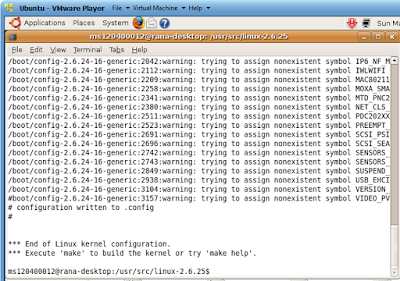How to:
Compile Linux kernel 2.6
Compiling
custom kernel has its own advantages and disadvantages. However, new Linux user
/ admin find it difficult to compile Linux kernel. Compiling kernel needs to
understand few things and then just type couple of commands. This step by step
howto covers compiling Linux kernel version 2.6.xx under Debian GNU Linux.
However, instructions remains the same for any other distribution except for
apt-get command.
Step
# 1 Get Latest Linux kernel code
Visit http://kernel.org/ and download the latest
source code. File name would be linux-x.y.z.tar.bz2, where x.y.z is actual
version number. For example file inux-2.6.25.tar.bz2 represents 2.6.25 kernel
version. Use wget command to download kernel source code:
$ cd /tmp
$ wget http://www.kernel.org/pub/linux/kernel/v2.6/linux-2.6.25.tar.bz2
$ cd /tmp
$ wget http://www.kernel.org/pub/linux/kernel/v2.6/linux-2.6.25.tar.bz2
Note:
Replace x.y.z with actual version number.
Step
# 2 Extract tar (.tar.bz3) file
Type the following command:
# tar -xjvf linux-2.6.25.tar.bz2 -C /usr/src
# tar -xjvf linux-2.6.25.tar.bz2 -C /usr/src
# cd /usr/src
Step
# 3 Configure kernel
Before you configure kernel make
sure you have development tools (gcc compilers and related tools) are installed
on your system. If gcc compiler and tools are not installed then use apt-get
command under Debian Linux to install development tools.
# apt-get install gcc
# apt-get install gcc
Now
you can start kernel configuration by typing any one of the command:
§
$ make menuconfig - Text based color menus,
radiolists & dialogs. This option also useful on remote server if you wanna
compile kernel remotely.
§
$ make xconfig - X windows (Qt) based
configuration tool, works best under KDE desktop
§
$ make gconfig - X windows (Gtk) based
configuration tool, works best under Gnome Dekstop.
For example make menuconfig
command launches following screen:
$ make menuconfig
$ make menuconfig
You
have to select different options as per your need. Each configuration option
has HELP button associated with it so select help button to get help.
Step
# 4 Compile kernel
Start compiling to create a
compressed kernel image, enter:
$ make
$ make
Start compiling to kernel
modules:
$ make modules
Install kernel modules (become a
root user, use su command):
$ su -
# make modules_install
$ su -
# make modules_install
Step
# 5 Install kernel
So far we have compiled kernel
and installed kernel modules. It is time to install kernel itself.
# make install
# make install
It
will install three files into /boot directory as well as modification to your
kernel grub configuration file:
§
System.map-2.6.25
§
config-2.6.25
§
vmlinuz-2.6.25
Step
# 6: Create an initrd image
Type the following command at a
shell prompt:
# cd /boot
# mkinitrd -o initrd.img-2.6.25 2.6.25
# cd /boot
# mkinitrd -o initrd.img-2.6.25 2.6.25
initrd
images contains device driver which needed to load rest of the operating system
later on. Not all computer requires initrd, but it is safe to create one.
Step
# 7 Modify Grub configuration file - /boot/grub/menu.lst
Open file using vi:
# vi /boot/grub/menu.lst
# vi /boot/grub/menu.lst
title Debian GNU/Linux, kernel 2.6.25
Default
root (hd0,0)
kernel /boot/vmlinuz root=/dev/hdb1 ro
initrd /boot/initrd.img-2.6.25
savedefault
boot
Remember to setup correct
root=/dev/hdXX device. Save and close the file. If you think editing and
writing all lines by hand is too much for you, try out update-grub command to
update the lines for each kernel in /boot/grub/menu.lst file. Just type the command:
# update-grub
Neat. Huh?
# update-grub
Neat. Huh?
Step
# 8 : Reboot computer and boot into your new kernel
Just issue reboot command:
# reboot
# reboot






No comments:
Post a Comment